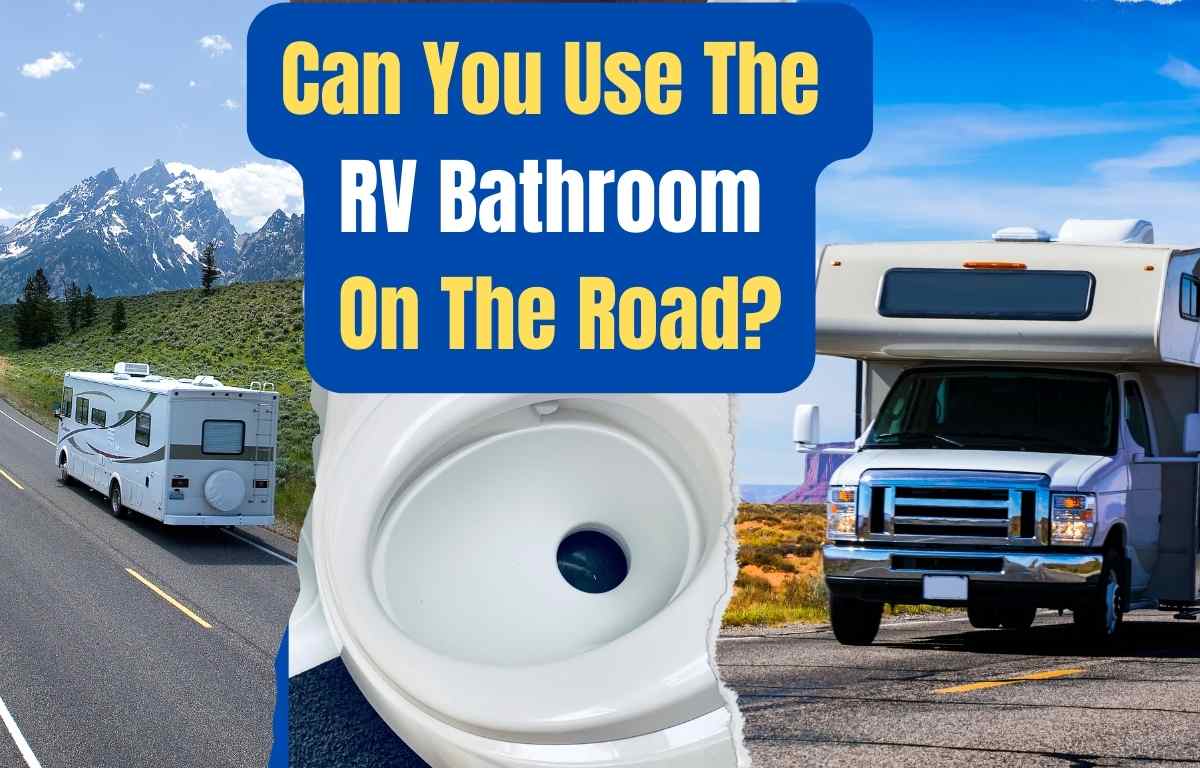One of the great things about a road trip in a recreational vehicle (RV) is the convenience it affords. Unlike other forms of travel, you have all of the amenities and comforts of home, including your kitchen, living area, entertainment, and bathroom. This brings us to a frequently asked question among RV owners and enthusiasts alike: Can you use the bathroom in an RV while it is in motion?

Using the bathroom in an RV while it’s in motion is technically possible, but it comes with significant safety considerations. RVs, like any moving vehicle, can experience sudden stops or swerves. If you’re not in a seat with a seatbelt during such events, you risk injury from collisions or abrupt stops. The lack of seatbelts in RV bathrooms further compounds this risk, making it as unsafe as being unbelted in any other part of the vehicle during transit.
Furthermore, moving around in a moving RV is risky. In the event of an accident, being mobile inside the RV could result in severe injuries, as the crash impact could cause you to be thrown around inside the vehicle. This danger is greater in RVs due to their size and the relatively limited safety features in the living quarters compared to those in cars, trucks, or the RV cockpit.
Seat belt regulations also play a role. While all states require front-seat passengers in RVs to wear seat belts, the rules for other occupants vary. Some states mandate that all passengers, regardless of where they are seated in the RV, must wear seat belts. In these states, finding a seat with a seat belt and remaining seated while the vehicle is moving is not just a safety recommendation but a legal requirement. Keep reading to learn more about this question and why you may want to think twice about using the bathroom when your RV is in motion.
Safety Considerations: Seat Belts and Sudden Stops
While using an RV’s bathroom is feasible in a moving RV, safety should be paramount. Similar to any moving vehicle, RVs can brake suddenly, swerve, or hit bumps. If you happen to be out of your seat when this happens, you risk injuries from a sudden stop or collision. You don’t want to be using the toilet, for many reasons, if the unforeseen happens.
Additionally, RV bathrooms aren’t equipped with seat belts, unlike the passenger seat. This absence of seat belts means that in the event of an abrupt halt, anyone in the bathroom would be as secure as the bottle of shampoo sitting on the vanity.
Moving Around in the RV While It’s on the Road
In a motorhome, it may seem like a relatively risk-free benefit to be able to move through the RV, but you need to remember that it’s still a vehicle on the road. Given its size, it arguably presents more risks than a regular car if you’re mobile during transit. In a car accident, your movement is limited, but in an RV, a crash could send you hurtling across the RV, potentially causing severe injuries. Did you ever see Anchorman? Well, the RV scene is pretty accurate. Additionally, there are relatively few safety features in the living quarters of an RV than there are in cars, trucks, or the RV cockpit. Therefore, some states have regulations prohibiting individuals from moving freely inside their RV while it’s moving.

While some regions might lack laws restricting such activities, it’s wise to remain seated while the RV is in motion. Legal or not, choosing to move around exposes you to potential harm. In the event of a crash, the injuries sustained could be life-altering.
Seat Belt Laws for RVs?
The requirements for seat belt use differ from one state to another. Nonetheless, all states necessitate that front-seat passengers wear their seat belts. In most states, this rule extends only to the front seats.

The other states require that every RV occupant, regardless of their seating position, buckle up when the RV is moving. For those traveling in these states, finding a seat with a seat belt is non-negotiable.
There may also be special rules for children, meaning that even if adults aren’t required to wear seat belts in the back of the RV, children may need to. With so many rules, it can be difficult to know what the law states. However, the best approach is to have everyone buckled up regardless of age or location if you have the option.
Check out this great article that lists the seat belt laws of every state: RV Seat Belt Laws in Every US State & Canada.
Can Passengers Move Around in a Motorhome While Driving?
If you have a motorhome, such as a class A, class B, and or class C drivable RV, you may be permitted to occupy the back of it when moving. While this may be permitted, it’s still not advisable to walk around the RV when it’s in motion. As mentioned above, a slight mishap on the road can lead to severe injury or even death if passengers aren’t buckled in. The best thing to do when driving, regardless of the RV, is to stay seated and buckled up. Newer motorhomes will have more seatbelt options for passengers in the back. For instance, a Class C motorhome may have lockable swivel chairs with seatbelts that can be pulled out when traveling.

Numerous states require constant seat belt use, making it illegal to walk around in the RV. However, even in states that don’t necessitate seat belts for passengers in the back, it’s still recommended to stay seated.
Regardless of the lack of laws barring movement in a moving RV, it’s safer to stay seated and fastened with a seatbelt. Roaming around could lead to severe injury or, in the worst cases, be fatal. Additionally, moving in the back can distract the driver, putting all the vehicle’s occupants at risk. Therefore, for everyone’s safety, it’s crucial to stay seated and wear your seat belt.
Is It Permissible for Passengers to be in Travel Trailers or 5th Wheels While in Transit?
The labyrinth of RV laws in the United States is characterized by significant variations across states, a fact that holds true for regulations around passengers occupying travel trailers and 5th wheels while in motion. A large number of states forbid it, dictating that passengers must be in the front seat only. This might necessitate the need for companions to tailgate in their personal vehicles if they’re joining you on the trip and intending to overnight in the trailer.

That being said, a handful of states do authorize passengers to be present in a travel trailer or fifth wheel while it’s moving. Some jurisdictions are flexible and apply this rule to both types of trailers, while others restrict it specifically to 5th wheels. Moreover, some states come with a provision allowing passengers to be in travel trailers and 5th wheels, provided there’s an operational two-way communication device facilitating conversation between the driver and passengers.
However, I would never suggest trying this. Aside from a very bumpy ride, a slight mishap can be fatal. Riding in a towable RV is not a good idea, regardless if the state’s laws permit it.
RV Bathroom Use When Traveling
One of the great things about RVs and motorhomes is the ability to take advantage of the comforts of home, no matter where you are. RVs are designed to be self-sufficient and used wherever they’re parked. Many of the benefits will apply to an RV in motion or when on the road.

While it’s not a smart idea to use your RV bathroom when traveling, as described above, it won’t harm your RV as your water system can work as if you were parked. This is good to know, especially since you have the option to easily pull over on the side of the road in a safe place and use your RV bathroom. So, if you’re driving down the road and nature calls for one of your passengers, you can simply pull into a rest stop or off the road, and your RV bathroom will be available for use.
Delving into RV Plumbing
Understanding the plumbing dynamics of an RV is an essential aspect of using your RV’s bathroom while traveling. From a plumbing perspective, using the toilet in a moving RV presents few complications. The functionality of an RV toilet is designed to handle the demands of a mobile environment. This is different from the household toilets you have at home.
In a typical RV toilet system, once the foot pedal is pressed or the handle is turned (depending on your RV’s toilet model), waste is transferred directly from the toilet bowl into a specially designed container called a black water tank. Your RV toilet works just as it would if you were parked. This tank is made to contain both liquid and solid waste securely. Importantly, the tank is engineered to withstand the rigors of travel. Therefore, even while your RV is in motion, the black tank can effectively manage waste without spilling or causing unpleasant odors.
The same holds true for other RV bathroom utilities like showers or sinks. Just like the toilet, these features can be used as long as the water pump is activated and you have fresh water in your tanks, guaranteeing a steady supply of water.
The water pump’s function is to draw water from the freshwater tank and push it through your RV’s plumbing system, thereby providing the necessary water flow for your RV shower, sink, and toilet.

Despite this ease of use, there are essential considerations to remember. Foremost is monitoring the level of your fresh water tank. You need to ensure there’s enough water for your travel needs, whether it’s for a quick shower, washing your hands, or flushing the toilet. It’s advisable to fill up your fresh water holding tank before embarking on a journey and keep a regular check on the water level during your trip.
Another critical aspect is wastewater management. Your RV is equipped with two kinds of wastewater tanks – the aforementioned black water tank for toilet waste and a grey water tank, which collects wastewater from your sinks and shower. Balancing usage and storage of your liquid waste is a crucial part of maintaining a well-operating septic system on the go. Regularly emptying your black and grey water tanks at a designated dump station is an important step in this process. Also, remember that full waste water tanks will add to the overall weight of your RV.
So, yes, your RV can handle being used while driving. However, stopping is always going to be the safest option and will not add much time to your trip. Additionally, I would never recommend some activities like taking a shower while moving. A wet shower floor and a small bump or swerve are just a recipe for someone to get hurt. Instead, pull into a parking spot and shower away.
Embracing the Art of Planning
Given the safety risks and possible legal implications, the best way to navigate bathroom needs on a road trip is to plan ahead. Schedule regular rest stops for bathroom breaks and stretch breaks and ensure the septic tank and sewer lines are properly managed. Your travel days will be much more enjoyable with a bit of planning.
Conclusion
While it is technically feasible to use an RV bathroom while the vehicle is in motion, it is generally not recommended due to potential safety hazards and legal issues. Prioritize safety over convenience to ensure a smooth journey to your next destination. After all, the joy of an RV trip is not just about the destination but also about the journey. Plan ahead, respect laws, and keep everyone’s comfort in mind for a memorable and hassle-free camping trip. Safe travels!
